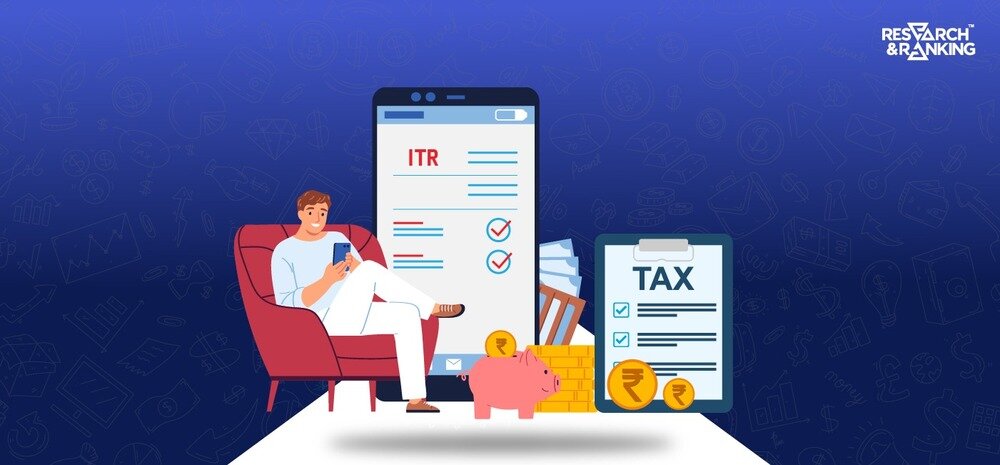Filing Income Tax Returns (ITR) online has become a streamlined and straightforward process in India, thanks to the digital initiatives of the Income Tax Department. E-filing of income tax not only saves time but also ensures accuracy and quick processing of tax returns.
Whether you are a seasoned taxpayer or new to the concept, understanding how to file ITR returns online is crucial to complying with the country’s tax laws.
What is Income Tax Return (ITR) Filing in India?
ITR filing in India is when a person declares their income, deductions, and tax payments for a particular financial year. It is a mandatory exercise for anyone earning a certain level of income, and it helps the government assess the tax liability of an individual or entity.
E-filing of income tax is not only about paying taxes; it also serves as an important document for availing loans, visas, and other financial services. You can also read more about the concept of taxation with our blog.
Also Read: How to pay less tax.
Documents Required For Income Tax E-Filing
Before you begin income tax e-filing, ensure you have the following documents ready:
- PAN (Permanent Account Number)
- Aadhaar Card
- Bank account details
- Form 16 (if employed)
- Proof of investments and savings
- Details of income from other sources (if any)
- Previous year’s tax returns
Which ITR Form Should You Choose for E-filing of Income Tax?
The Income Tax Department has designated different forms for different categories of taxpayers:
- ITR-1 (Sahaj): This form is for individuals earning income from salaries, one-house property, and other sources (interest, etc.) and having a total income of up to ₹50 lakhs.
- ITR-2: For individuals and HUFs not carrying out business or profession under any proprietorship.
- ITR-3: For individuals and HUFs having income from a proprietary business or profession.
- ITR-4 (Sugam): For presumptive (assumed) income from business & profession without actual estimation of net income
Choose the form that best suits your income structure.
How To File Income Tax Returns Online?
Step 1 :
- Navigate to the official Income Tax E-filing portal.
Step 2:
- Log in by entering the required details for:
- Your User ID or PAN
- Your Password
- Captcha code
- Once you are done, navigate to the ‘E-File’ menu and click the ‘Income Tax Return’ option.
- This should redirect you to the main Income Tax Return page.
Step 3:
- The PAN will be auto-filled on the Income Tax Return page.
- You will need to provide the following details:
- Assessment Year. (This is the financial year that follows the financial year in which your income was earned)
- Income Tax Return Form Number. ( Filing of ITR 1 and ITR 4 can be done online)
- Filing Type.
- Submission Mode. (The option of ‘Prepare and Submit Online is available here)
Step 4:
- Click on ‘Continue’.
- Navigate to the ‘Mode of Filing’.
- Select ‘Online’ from the drop-down menu.
- Click on ‘Proceed’.
Step 5:
- Click on ‘Status’
- Select Individual, Hindu Undivided Family (HUF), or Firm/LPP depending on what is applicable.
Step 6:
- Select the required Income Tax Return Form. (ITR 1 and ITR 4 are available for E-filing).
Step 7:
- If ITR 1 is selected, you must complete the five following sections:
| Section | Details |
| Personal Information | Your Full NameYour PANYour Aadhar Number |
| Gross Total Income | Enter and Verify your income from eligible sources (Salary, pension, house property, interest income, family pension, etc.)If applicable, you must provide details of your exempt income. |
| Total Deductions | Taxes you have paid from sources but are not limited to Tax Deducted at Source (TDS), Tax Calculated at Source (TCS), Advance Tax, and Self-Assessment Tax. |
| Tax Paid | Tax Liability is based on the sections you filled out above. Tax payable on Total Income = (Income—deductions claimed—tax paid till date). If the amount calculated here is negative, you can claim it in refunds. However, a positive amount needs to be paid as tax. |
| Total Tax Liability | Tax Liability is based on the sections you filled out above. Tax payable on Total Income = (Income – deductions claimed – Tax paid till date)If the amount calculated here is negative, you can claim it in refunds. However, a positive amount needs to be paid as tax. |
Step 8:
- If ITR 4 is selected, you must complete six sections, out of which five remain the same as above.
| Section | Details |
| Disclosures | Financial details related to your business. (revenue, expenses, profits, losses, assets, liabilities, investments)Information on Gross Receipts reported for GST, and exempt income earned by the business must be added. |
| Personal Information | Same as mentioned above. |
| Gross Total Income | |
| Total Deductions | |
| Tax Paid | |
| Total Tax Liability |
Step 9:
- A summary of the tax computation for the current financial year will be provided to you on the screen.
- This summary is based on the information you provided earlier.
- The webpage will calculate your tax amount, determining whether you owe tax or if you are eligible for a tax refund.
- Once done with previewing, enter the details of your residence.
- Click on ‘Submit’
Step 10:
- Click on the ‘Proceed to Validation’ option.
- The following verification options can be selected to verify the Income Tax Return:
- E-Verify.
- E-Verify later within 120 days from the date of filing.
- E-Verify via ITR-V through regular or speed post within 120 days from the filing date. ( Addressed to Centralised Processing Center, Income Tax Department, Bengaluru – 560 500 )
- If you choose the self-e-verification option, an Electronic Verification Code (EVC) or One-time Password (OTP) must be generated to complete the process.
- It can be done in the following ways:
- Generation of Electronic Verification Code (EVC) through the taxpayer’s bank ATM.
- Generation of One-time Password (OTP) through Aadhar Card.
- Using a pre-validated bank account.
- Using a pre-validated Demat account.
- If you choose the option of self-e-verification, a copy of the ITR form must be sent to CPC Bengaluru at the address mentioned in the form.
- Verify the details and click on ‘Preview and Submit.’
Step 11:
- Click on ‘Submit’ to submit the Income Tax Return.
- An acknowledgment will be sent to the email ID you submitted.
Conclusion
E-filing income tax is a significant step towards financial responsibility and compliance with Indian tax laws. Although the process is detailed, the Income Tax Department’s user-friendly portal and comprehensive instructions make it easy.
Remember, timely income tax e-filing not only helps avoid penalties but also aids in faster processing of refunds, if any. The online filing process can be completed smoothly and efficiently with the right documents and a clear understanding of the applicable ITR form.
Optimal financial planning and understanding the details of new vs old tax regimes are crucial for making the most out of the deductibles in the ITR. You can read our blogs to learn more about portfolio management and stock market advisory.
Frequently Asked Questions
How to file an income tax return online for a revised return?
You can file income tax returns for revised returns using the same procedure mentioned above. In the’ Filing Type’ section, select the ‘Revised Returns’ option.
How to file an income tax return online for self-employed individuals?
If you are self-employed, you can follow the instructions above to file your ITR online. You can download the ITR 4 and compute the tax using Form 26AS.
Can I file my ITR myself online without CA?
Yes, you can file your Income Tax Return (ITR) yourself online via the official website of the Income Tax Department. The e-filing system provides step-by-step guidance, making it accessible for individuals to file their returns without professional help. Always double-check your information for accuracy before submission.
Can income from freelancing or side businesses be included in the tax calculation, and how?
Yes, freelancing or side business income must be included under ‘Profits and Gains of Business or Profession.’ Deduct legitimate business expenses to lower taxable income. Keep detailed records of all transactions and consider paying advance tax if applicable.
If you are filing your taxes for the first time, consult a tax professional to ensure compliance and optimized tax deductions specific to your business activities.
How useful was this post?
Click on a star to rate it!
Average rating 5 / 5. Vote count: 1
No votes so far! Be the first to rate this post.
I’m Archana R. Chettiar, an experienced content creator with
an affinity for writing on personal finance and other financial content. I
love to write on equity investing, retirement, managing money, and more.
- Archana Chettiar













